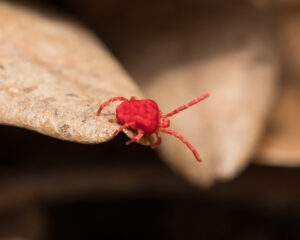Clover Mites
It’s an ant! It’s a spider! No…it’s a clover mite. That’s right, all those tiny, reddish-brown spots that move around are actually mites. These pests are smaller than a pinhead but are usually noticed because of the incredible numbers gathered together this time of year when the weather is cool and sudden changes in weather are common.
Clover mites flourish in cooler springtime weather due to the prolific growth of tender new plants that serve as food sources for the mites. As you can probably guess from the name, clover mites enjoy fine dining on clover plants. What you may not know is that they also enjoy tender young grasses, daffodils, strawberries, salvia, primrose, and many more. It is quite common to see these insects in droves during the spring season here in Georgia, and you will usually see their numbers diminish greatly as the weather heats up in late spring and early summer. During this time is when eggs are laid and the clover mite goes into a kind of dormancy until food is available again the next spring.
So, what’s the big deal? Why do homeowners care about the lowly clover mite? Well, while it is true they do not bite or sting, they are nonetheless a pest due to the invasion into homes and the location of future egg-laying sites. Homeowners will notice that if smashed, this little bug leaves a red stain on light-colored furniture, curtains, and walls. It is also important to note that eggs are often laid in the cracks and crevices of the exterior of a home or even between the walls.
Now to the question of what can be done to control clover mites in and around our homes. First of all, the homeowner should consider preventative measures to avoid problems with the mites. Since it has been noted above that there are certain plants the mites are attracted to more than others, it would be wise to consult an expert in the field to decide which plants to place in the direct perimeter of your home. There are plants that are actually distasteful to the clover mite. A few of these plants include petunias, salvia, geranium, roses, arborvitae, and juniper. A distance of 18-24 inches should be left between plants and the home’s exterior in any case.
After dealing with the plants around the home, another preventative measure would be frequent inspections of the foundation, siding, and window frames to ensure there are no entry points such as cracks available to the pests.
But what if you already have the annoying little critters? There are definitely steps you can take to remedy the situation. If there are bugs on the outside of your home, spraying the surface with the water hose is an easy but of course temporary solution. Inside the home, you should vacuum the mites so that they are not crushed and stain your rugs or furniture. Be sure to dump the vacuum bag afterward. If this sounds like a lot of work, no worries, Canton Termite has you covered. We are here to help you safely and effectively resolve your pest problem. Give us a call today at 770-479-1598 and let us help. Let our Canton Termite family help your family by ensuring you are pest-free!
By: Tim

